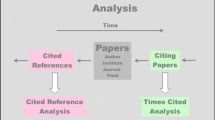Abstract
An analysis of three major problems in the application of bibliometric research performance indicators is made in three separate sections. In the first section, the influence of field-dependent citation practices is analysed. The results indicate that rankings of publications from different fields, based on citation counts, can be affected seriously by differences between citation characteristics in those fields. If certain assumptions hold, one should expect high (short term) citation levels in Biochemistry, Celbiology and Biophysics. Medium citation levels are to be expected in Experimental and Molecular Physics, Physical and Organic Chemistry, Pharmacology and Plant Physiology, and low citation levels in Mathematics, Taxonomy, Pharmacognosy and Inorganic Solid State Chemistry. In the second section time-dependent factors are studied. It is shown that trend-analyses of output and impact based on bibliometric scores can be disturbed by changes in theSCI-database and in publication and citation practices. One of the disturbing factors is shown to be the inclusion of so called Books into theSCI data-base in 1977. Finally, in the third section a case is presented which illustrates the consequences of operating on incomplete bibliometric data in the evaluation of scientific performance. A completeness percentage of 99% for publication data is proposed as a standard in evaluations of the performance of small university research groups).
Similar content being viewed by others
Notes and references
H. F. MOED, W. J. M. BURGER, J. G. FRANKFORT, A. F. J. VAN RAAN,On the Measurement of Research Performance: the Use of Bibliometric Indicators, Research Policy Unit of the University of Leiden, Leiden, 1983.
H. F. MOED, W. J. M. BURGER, J. G. FRANKFORT, A. F. J. VAN RAAN, The use of bibliometric data for the measurement of university research performance,Research Policy, to be published.
H. F. MOED, W. J. M. BURGER, J. G. FRANKFORT, A. F. J. VAN RAAN, A comperative study of bibliometric past performance analysis and peer judgement,Scientometrics, 8 (1985) 149.
The Science Citation Index, published by ISI.
E. GARFIELD,Citation Indexing — Its Theory and Application in Science, Technology, and Humanities, Wiley & Sons, New York, 1979.
See W. L. HAYES,Statistics for the Social Sciences, Holt, Rinehart and Winston, London 1973, Chapter 10.17 for more details.
D. DE SOLLA PRICE, The citation cycle, in:Key Papers in Information Science, B. C. GRIFFITH (Ed.) White Plains, New York, 1980, p. 195–210.
See E. GARFIELD, Preface to 1982 SCI-Users Gide,Users gide for the Science Citation Index, 1982.
National Survey Committee on Biochemistry (Verkenningscommissie Biochemie),Over Leven, Staatsuitgeverij, The Hague, 1982.
Author information
Authors and Affiliations
Rights and permissions
About this article
Cite this article
Moed, H.F., Burger, W.J.M., Frankfort, J.G. et al. The application of bibliometric indicators: Important field- and time-dependent factors to be considered. Scientometrics 8, 177–203 (1985). https://doi.org/10.1007/BF02016935
Received:
Issue Date:
DOI: https://doi.org/10.1007/BF02016935




